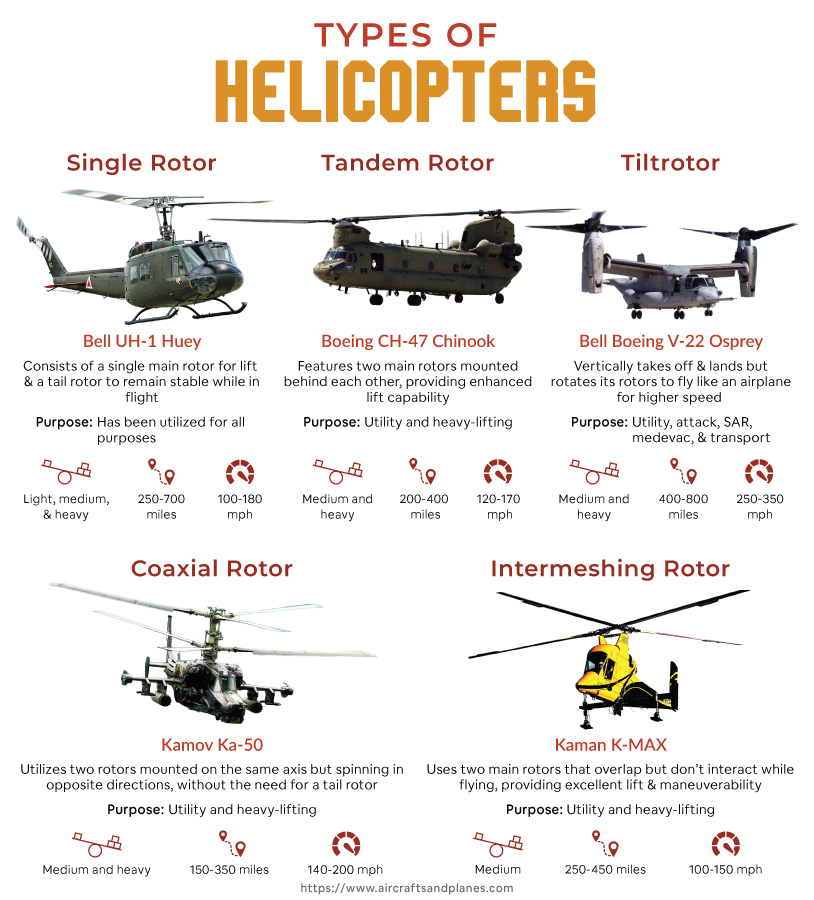The helicopter has come a long way since its humble origins as a child’s toy in China. As the years passed, the helicopter underwent numerous tweaks in its design, leading to different models emerging. Most of the time, these were born out of a need for greater specialization, including features like greater load capacity, easier maneuverability, and higher speeds. However, due to the level of customization involved, it can be challenging to classify all helicopters under a single banner.
How Helicopters are Classified
There are a few criteria to consider when categorizing helicopters. While the type of rotor is one of the main ways of identifying a helicopter, other factors are also important.
By Purpose
Helicopters have several uses and are often customized in a certain way to suit a unique purpose. For instance, military helicopters utilized by armed forces will often have additional weaponry and sensory equipment, which civilian helicopters used for transportation and tourism will lack.
- Utility Helicopters: Used for general purposes, including transport, cargo lifting, and other similar applications.
- Attack Helicopters: Used in military operations, often equipped with additional weapon systems.
- Search and Rescue (SAR) Helicopters: Used to locate and rescue individuals in trouble, often possess specialized equipment like hoists and winches.
- Medical Evacuation (Medevac) Helicopters: Used to transport injured or critically ill patients, often configured with medical equipment and personnel.
- Transport Helicopters: Used for passenger transportation like VIPs, tourists, and corporate travel.
- Heavy-lift Helicopters: Used to lift heavy loads, often used in construction, logging, and related industries.
- Training Helicopters: Used to train pilots, often with simplified controls and systems.
- Scout Helicopters: Used for reconnaissance and surveillance missions, often with sensors.
By Size
- Light Helicopters: Small but nimble, with a maximum take-off weight (MTOW) of under 4,400 lbs.
- Medium Helicopters: Intermediate, with a maximum take-off weight (MTOW) between 4,400 lbs and 17,600 lbs.
- Heavy Helicopters: Large and durable, with a maximum take-off weight (MTOW) of over 17,600 lbs.
By Rotors

Helicopters take flight with the help of rotors. These generally consist of a main rotor that helps generate lift and an anti-torque control that opposes the aerodynamic drag of the main rotor.
| Type of Helicopter | How Does it Work | Purpose | Size | Range | Speed | Examples |
|---|---|---|---|---|---|---|
| Single Rotor | Uses a single main rotor for lift and a tail rotor to remain stable | Has been utilized for all purposes | Light, medium, and heavy | 250-700 miles | 100-180 mph | Bell UH-1 Huey, Sikorsky UH-60 Black Hawk |
| Tandem Rotor | Features two main rotors mounted behind each other, providing enhanced lift capability | Utility and heavy-lifting | Medium and heavy | 200-400 miles | 120-170 mph | Boeing CH-47 Chinook, Boeing Vertol 107-II |
| Tiltrotor | Can vertically take off and land like a helicopter but rotate its rotors to fly like an airplane for higher speed and efficiency | Utility, attack, SAR, medevac, and transport | Medium and heavy | 400-800 miles | 250-350 mph | Bell Boeing V-22 Osprey, Focke-Achgelis Fa 269 |
| Coaxial Rotor | Utilizes two rotors mounted on the same axis but spinning in opposite directions, eliminating the need for a tail rotor | Utility and heavy-lifting | Medium and heavy | 150-350 miles | 140-200 mph | Kamov Ka-50, Sikorsky X2 |
| Intermeshing Rotor | Uses two main rotors that overlap but don’t touch, providing excellent lift and maneuverability | Utility and heavy-lifting | Medium | 250-450 miles | 100-150 mph | Kaman K-MAX, SNCAC NC.2001 Abeille |
Certain helicopters, like the Sikorsky S-97 Raider, utilize additional propulsion systems and fixed wings. These helicopters, called compound helicopters, do not solely rely on the lift generated by the main rotor. As such, they can often reach speeds of up to 220 mph and cover ranges of around 600 miles.
By Motor
While most helicopters still use traditional combustion engines, newer ones are being developed to run on electric batteries. An electric helicopter has several noteworthy advantages over its older counterparts – reduced emissions, lower operation costs, and fewer mechanical components that could potentially fail. However, these helicopters remain mostly experimental and can only travel over short ranges, though models with larger ranges will most likely be developed.
FAQs
The ultra-light Mosquito XEL can be flown without a pilot’s license. However, a certain amount of additional training is necessary before even an amateur can fly one.